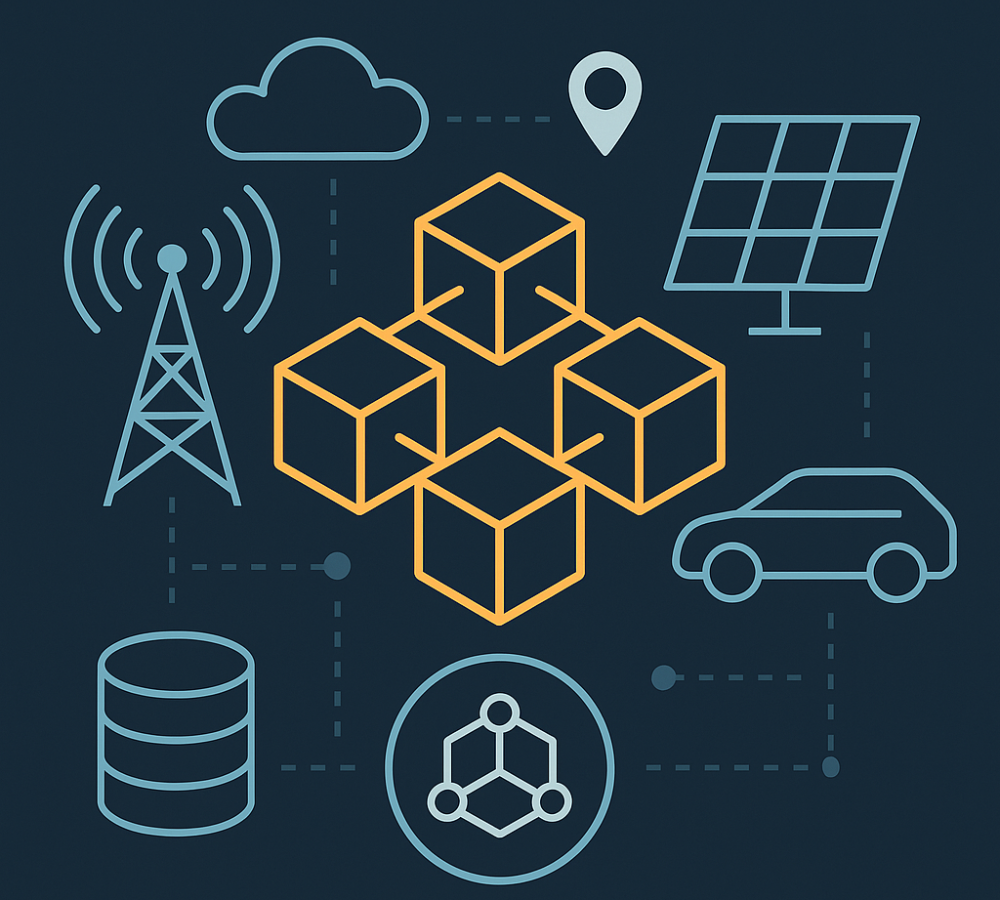Introduction
In the realm of blockchain technology, DePIN (Decentralized Physical Infrastructure Network) is in a whole new stage of development. DePIN shifted away from all things crypto and into something more concrete. It all comes down to developing and maintaining practical infrastructure, such as decentralized energy grids, mobility solutions, data storage, and wireless networks.
In this blog, we will explain everything you need to know about DePIN: what it is, how it works, why it matters, and which are the projects bringing it to life. Whether you are a crypto enthusiast, investor, or simply curious, you will be ready for why DePIN is the real-world use case Web3 has been waiting for.
What Is DePIN (Decentralized Physical Infrastructure Network)?
Whereas anything that has real-life infrastructure development and maintenance described in terms of a system will be related to DePIN, the DePIN helps these companies basically abruptly enforce infrastructure over tokenized incentives. This is in stark contrast to traditional infrastructure, which is usually controlled by corporations or governments.
That is, decentralized platforms compensate contributors with tokens for providing resources such as bandwidth, storage, or energy. These platforms then serve their users in a manner very similar to the centralized alternatives but in a more transparent and democratic way.
Key Characteristics of DePINs:
| Feature | Description |
|---|---|
| Decentralized Ownership | Infrastructure is owned and operated by a distributed group of contributors. |
| Token Incentives | Participants earn tokens for their services or hardware contribution. |
| Permissionless Participation | Anyone can join the network by adding infrastructure. |
| Smart Contracts | Automate payment, verification, and coordination processes. |
| Low Entry Barriers | Users can contribute using off-the-shelf hardware in many cases. |
Why DePIN Matters: Real-World Problems, Web3 Solutions
Most crypto projects operate purely online. DePIN pushes blockchain into the physical world to solve real infrastructure problems:
- Cost Efficiency: Infrastructure in the physical world includes intermediaries and red tape. DePIN cuts red tape, thus cutting operational costs.
- Unlocked Access: In underserved and rural communities, critical infrastructure is frequently absent. DePIN lets individuals build and expand these networks on their own.
- Incentivized Growth: Quick and organic growth of the network takes place due to token rewards in such a way that centralized capital is not needed.
- Transparency and Trust: Blockchain is the technology that guarantees that infrastructure contributions and usage are tracked, verifiable, and immutable.
By decentralizing control and allowing open participation, DePIN seeks to procure an economic model that aligns incentives with infrastructure development; a task that has proven tiring for both governments and corporations.
How DePIN Works: Breaking Down the Mechanism

Let us break down the mechanisms behind how DePIN systems operate into four constituent parts:
1. Hardware Contributors
These are participants who contribute with physical infrastructures, e.g. antennas, routers, storage, solar panels.
2. Blockchain Layer
The network utilizes smart contracts and ledgers to coordinate activity, verify contributions, and issue payments.
3. Tokenomics
Each DePIN project has its own native token to reward contributors and is used to pay for services on the network.
4. Oracles & Verification
For many DePINs, oracles or reputation systems are used to verify that the infrastructure is working and the data is accurate.
Popular DePIN Projects Leading the Way
Some DePIN projects have achieved considerable success in 2024 and are continuing their expansion in 2025. Here are some projects:
Helium Network
- Use Case: Wireless decentralization (5G & LoRaWAN)
- How It Works: Users deploy Hotspots, earning HNT tokens for providing network coverage.
Render Network
- Use Case: Workloads involving 3D and AI that require decentralized GPU rendering.
- How It Works: GPU owners contribute compute power, earning RNDR tokens from users needing rendering tasks.
Filecoin
- Use Case: Decentralized file storage.
- How It Works: Storage providers offer disk space to users. Smart contracts ensure file integrity.
DIMO
- Use Case: IoT vehicle data infrastructure.
- How It Works: Car owners collect and sell vehicle data through connected devices.
These platforms prove that DePIN isn’t a concept—it’s live, scaling, and real.
DePIN vs Traditional Infrastructure: A Head-to-Head Comparison
| Aspect | Traditional Infrastructure | DePIN Model |
|---|---|---|
| Ownership | Centralized (govt/corporate) | Distributed (users) |
| Expansion Speed | Slow, top-down | Fast, bottom-up |
| Incentives | Often misaligned | Crypto-token based |
| Access | Limited by capital/policy | Global & open |
| Transparency | Opaque systems | Blockchain-based |
The contrasts are pretty clear in these definitions. DePIN takes ownership of its infrastructure, like the internet, away from the government and corporations.
Use Cases Across Industries
DePIN is applicable not only to storage and networks but also to the revolution of several industries:
Energy
- Community-powered solar grids can be tokenized for energy sharing.
- Companies like Powerledger explore peer-to-peer electricity trading.
Supply Chain
- IoT sensors on decentralized networks ensure transparent, immutable tracking.
- Pharmaceuticals, food safety, and agriculture would all be impacted.
Urban Development
- Decentralized smart city sensors for air quality, traffic, and water management.
- Lower maintenance costs and improved data ownership.
Economic Model: Token Incentives and Sustainability
Tokenomics form the very core of DePIN. The token model must balance:
- Contributor Rewards: To those who certify data or create infrastructure.
- User Fees: Charged to the consumers as payment for using network services.
- Governance: Token holders get to vote on protocol amendments or funding decisions.
Token inflation and reward sustainability remain challenging jobs. Halvings, dynamic pricing, and staking models become an option for protecting the long-term sustainability of many networks.
Risks and Challenges of DePIN
Despite its potential, DePIN presents some obstacles to itself:
- Hardware Costs: Initial infrastructure setup may deter casual users.
- Regulatory Concerns: Some jurisdictions might impose restrictions on physical deployments or regulate them.
- Security Risks: These devices are exposed, therefore they may be hacked or tampered with.
- Scalability: It’s difficult to coordinate thousands of dispersed devices.
- Economic Sustainability: Token inflation can deteriorate long term value.
Overcoming these barriers requires better hardware design, secure firmware, community governance, and real service demand.
The Future of DePIN: What Lies Ahead?
As AI, IoT, and blockchain converge, DePIN networks are poised to reshape global infrastructure models.
By 2030, we could see:
- Decentralized cloud computing replacing AWS-like services
- Global decentralized mesh networks providing internet access
- Crypto-powered smart cities with citizen-run infrastructure
- Cross-chain DePIN coordination for interoperable infrastructure ecosystems
And importantly, regulatory frameworks are evolving. Governments are beginning to notice DePIN’s potential, both as an innovation engine and as a decentralized alternative to monopolistic infrastructure providers.
Final Thoughts: Why DePIN Matters More Than Ever
We often talk about crypto going mainstream. DePIN might be the key that unlocks that future.
Rather than just trading coins, users can now build physical infrastructure, earn passive income, and contribute to global progress. In a world dominated by centralized control, DePIN empowers the people.
It’s not just another Web3 trend—it’s a movement. It connects your router, your rooftop solar, or your idle GPU to a decentralized global economy.
So next time you hear about DePIN, remember:
It’s crypto you can touch.
FAQs
A1. DePIN stands for Decentralized Physical Infrastructure Networks. It refers to blockchain-based networks that fund, build, and manage real-world infrastructure like wireless networks, sensor grids, energy systems, and cloud storage—powered by crypto tokens and decentralized participation.
A2. DePIN projects use blockchain technology to coordinate and incentivize users to contribute physical resources (e.g., hardware, connectivity, or energy). In return, contributors earn crypto tokens. This model decentralizes infrastructure ownership and cuts out traditional intermediaries.
A3. Notable DePIN projects in 2025 include:
Helium (HNT) for decentralized wireless networks
Render Network (RNDR) for distributed GPU rendering
Filecoin (FIL) for decentralized storage
WeatherXM for community-owned weather stations
DIMO for vehicle data monetization
A4. You can earn crypto by:
Hosting DePIN hardware (like Helium hotspots)
Providing internet, compute power, or storage
Sharing sensor or location data
Participating in project governance and staking
A5. Most DePIN projects rely on open-source code and community validation, but risks like hardware failure, regulation, or token volatility still exist. It’s important to research each project thoroughly before investing or deploying resources.
A6. Traditional infrastructure is centralized and owned by corporations or governments. DePIN flips this model by allowing individuals and communities to co-own and operate infrastructure, coordinated by smart contracts and crypto incentives.

